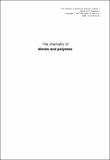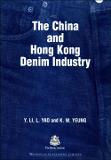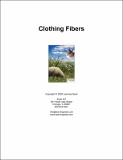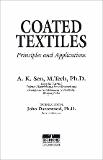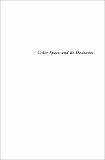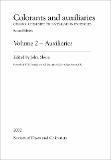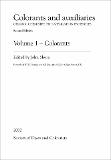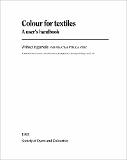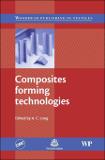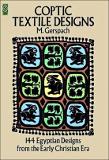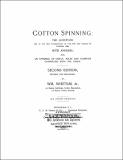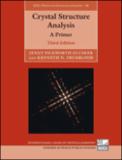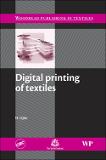Browsing Textile Engineering by Title
Now showing items 16-35 of 146
-
The chemistry of dines and polyenes; Volume 1
(John Wiley, 1997)Dienes and polyenes are an extremely important group of chemicals in the investigation of different types of syntheses. Dienes and Polyenes are found in a large number of natural and man-made products including such natural ... -
Chemistry of the textile industry
(Blackie Academic and Professional, 1995)The manufacture and processing of textiles is a complex and essential industry requiring many diverse skills to ensure profitability. New products are continually being developed, and reflect the energy and innovation of ... -
The China and Hong Kong denim industry
(Woodhead, 2003)Based on extensive primary research The Chinese and Hong Kong denim industry is the first title of its kind that contains a systematic description and analysis of the denim textile and clothing industry in mainland China ... -
Clothing appearance and fit: science and technology
(Woodhead, 2004)Fashion and beauty have helped shape history and today more than ever, we find ourselves under increasing pressure to think about what we wear, what we look good in and how best to enhance our body shape and size. Behind ... -
Clothing fibers
(Learning Seed, 2008) -
Coated and laminated textiles
(Woodhead Publishing, 2002)Coating and lamination offer methods of improving and modifying the physical properties and appearance of fabrics and also the development of entirely new products by combining the benefits of fabrics, polymers and films.This ... -
Coated textiles: principles and applications
(Technomic, 2001)Chemical protective clothing, architectural fabrics, air bags Intensive research and development in coated-fabric materials and processes has led to new and improved products for a wide range of consumer, industrial, ... -
Color space and its divisions: color order from antiquity to the present
(John Wiley, 2003)It has been postulated that humans can differentiate between millions of gradations in color. Not surprisingly, no completely adequate, detailed catalog of colors has yet been devised, however the quest to understand, ... -
Colorants and auxiliaries: organic chemistry and application
(Society of dyers and colourists, 2002)This second volume of the book collects together a remarkable quantity and variety of factual information linking the application properties of auxiliary products in textile coloration and related processes to as much as ... -
Colorants and auxiliaries: organic chemistry and application properties; Volume 1 - Colorants
(2002)This first volume of the book is concentrated on the chemical characteristics of dyes and pigments, with emphasis on attempts to interpret their colouring and fastness properties in terms of the essential structural features ... -
Colour for textiles: a users handbook
(Society of dyers and colourists, 1993)For many years the Society of Dyers and Colourists has been aware of the need for a book covering the basic science and technology of textile coloration for the benefit of readers without a detailed scientific background. ... -
Composites forming technologies
(Woodhead and The Textile Institute, 2007)Composite materials are available in many forms and are produced using a variety of manufacturing methods. A range of fibre types is used ± primarily carbon and glass ± and these can be combined with a variety of ... -
Coptic textile designs: 144 Egyptian designs from the early christian era
(Dover, 1975)Commercial artists and designers looking for strong, novel motifs for their graphics, textiles, advertising, will find this volume a rich source book. 153 designs, including 9 in color on the covers, include animals, ... -
Cotton spinning: the questions with answers
(C. A. M. Praray, Providence, R. I. & Charlotte, N. C., 1889)Cotton Spinning: This book contains the questions that were set at the may examination of the city and guilds of London, 1889, with the answers. Also includes an appendix of useful rules and examples connected with the ... -
Cotton: science and technology
(Woodhead Publishing, 2007)Despite the increased variety of manufactured fibres available to the textile industry, demand for cotton remains high because of its suitability on the basis of price, quality and comfort across a wide range of textile ... -
Crystal structure analysis: a primer
(Oxford University Press, 2010)Crystal Structure Analysis, Third Edition, explains how and why the detailed three-dimensional architecture of molecules can be determined by an analysis of the diffraction patterns obtained when X-rays or neutrons are ... -
Design and manufacture of textile composites
(Woodhead, 2005)Design and manufacture of textile composites is an invaluable guide for manufacturers of polymer composite components, end-users and designers, researchers in the fields of structural materials and technical textiles and ... -
Digital printing of textiles
(Woodhead and The Textile Institute, 2006)At present the textile industry produces the majority of its 34 billion square yards of printed textile fabric by screen printing. However as we move into the digital age developments in digital printing of paper are being ... -
Dyes and pigments: new research
(Nova Science, 2009)Dyes and pigments are substances that impart colour to a material. The term colorant is often used for both dyes (also called dyestuffs) and pigments. The major difference between dyes and pigments is solubility (the ... -
Dynamics of fibre formation and processing: modelling and application in fibre and textile industry
(Springer, 2007)This practice-oriented book deals with the modelling of steady state and non-steady state basic processes of fibre formation and fibre processing. Focal points are melt spinning processes, spun yarn spinning processes and ...

